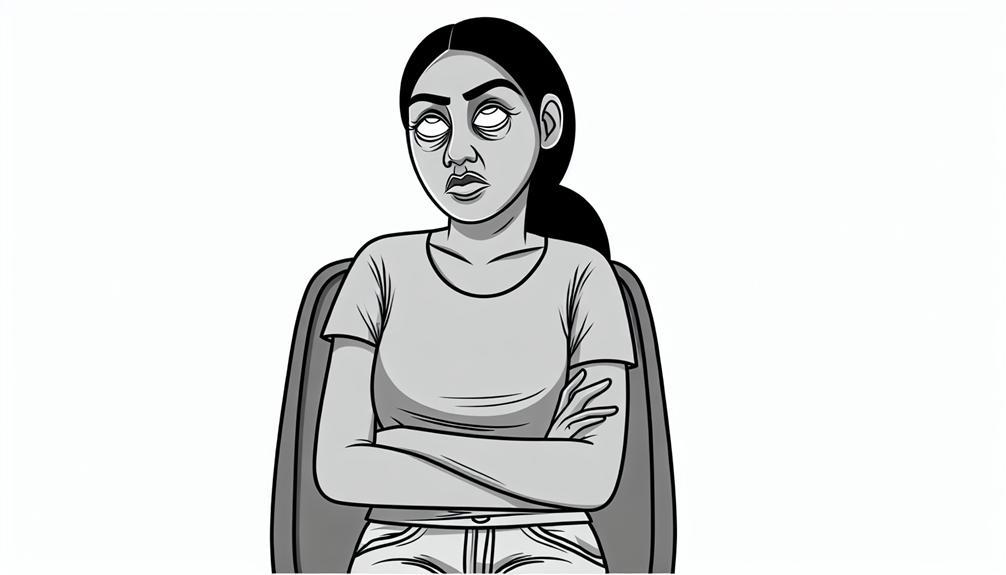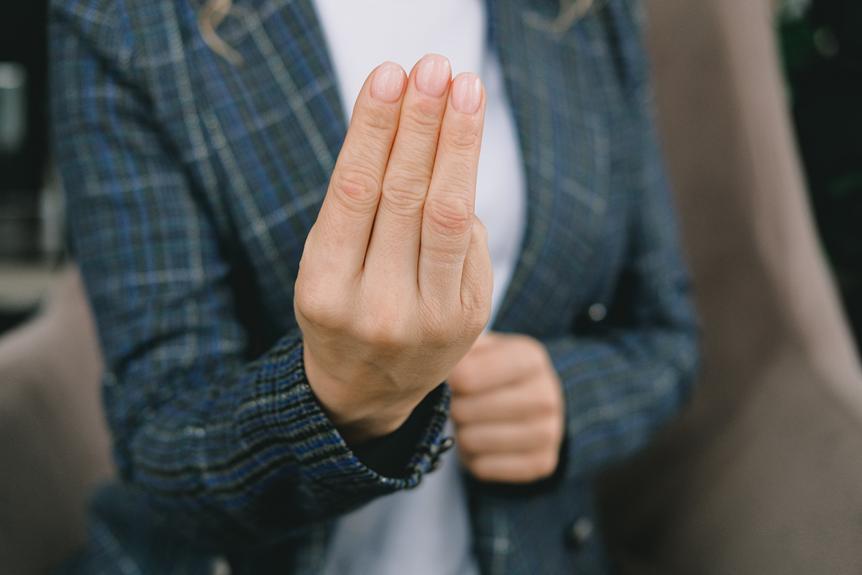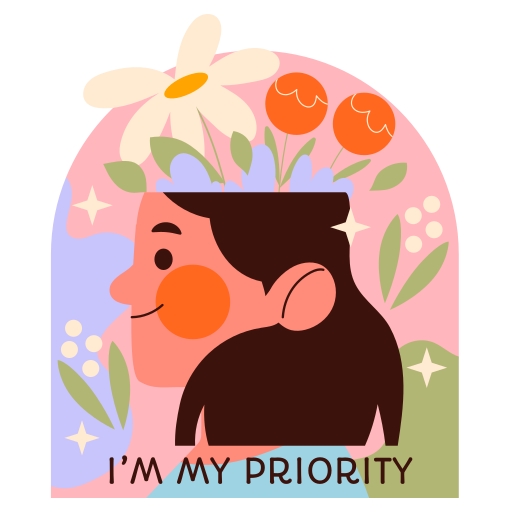Passive-aggressive behavior often lurks beneath the surface, hidden in nonverbal cues that can speak volumes without a single word being uttered. These subtle signals, ranging from folded arms to subtle eye movements, offer a window into unspoken emotions that can impact interactions more than we realize. By honing in on these nonverbal indicators, individuals can uncover hidden tensions and pave the way for more effective communication. In a world where what remains unsaid can sometimes be more potent than words themselves, understanding these nonverbal signals becomes a crucial skill in navigating the complexities of human interaction.
Crossed Arms and Legs
When individuals exhibit crossed arms and legs, they often convey nonverbal signals of defensiveness or resistance in social interactions. This defensive body language can indicate a subconscious attempt to create a physical barrier as a response to feeling threatened or uncomfortable. In terms of power dynamics, crossing arms and legs can be a way for individuals to establish a sense of control or assert dominance in a situation. By adopting this posture, they may be signaling a lack of openness or receptiveness to the ideas or opinions being presented. Understanding these nonverbal cues is crucial in interpreting the underlying emotions and attitudes of others, allowing for more effective communication and the establishment of appropriate boundaries in various social contexts.
Eye Rolling and Sighing
The nonverbal expressions of eye rolling and sighing commonly communicate underlying feelings of frustration or disapproval in interpersonal interactions. These gestures can present communication challenges by indicating impatience, annoyance, or lack of interest in the conversation. Eye rolling is often seen as a dismissive or disrespectful behavior, while sighing can convey exasperation or disappointment. Both actions may suggest a passive-aggressive response to a situation, where individuals express their emotions indirectly. Recognizing these emotional expression techniques is crucial for improving communication and addressing underlying issues in relationships. By acknowledging and discussing the impact of eye rolling and sighing, individuals can work towards more open and honest interactions, setting clear boundaries for constructive dialogue.
Poor Posture
In the realm of nonverbal communication, poor posture serves as a subtle yet impactful indicator of underlying emotions and attitudes. When individuals display poor posture, it can convey a lack of confidence, disinterest, or even defiance. To address and understand the implications of poor posture effectively, consider the following:
- Improving alignment: Proper posture can positively impact both physical and emotional well-being.
- Ergonomic adjustments: Making changes to your workspace or daily habits can help promote better posture.
- Body-mind connection: Posture can influence mood and mindset, so paying attention to how you carry yourself is essential for overall health and communication effectiveness.
Lack of Eye Contact
An absence of direct eye contact can often serve as a significant indicator of underlying emotions and communication challenges in interpersonal interactions. Individuals displaying a lack of eye contact may struggle with assertiveness, confidence, or feelings of discomfort. Improving assertiveness can help individuals feel more empowered to maintain eye contact, which is crucial for effective communication and building trust in relationships. Building confidence plays a vital role in overcoming the barriers that lead to avoiding eye contact. By addressing these underlying issues, individuals can enhance their communication skills, convey their messages more effectively, and establish healthier boundaries in their interactions. Developing assertiveness and confidence are key steps towards fostering better nonverbal communication through maintaining appropriate eye contact.
Exaggerated Sighing

Exaggerated sighing, a subtle yet impactful nonverbal cue, can convey underlying emotions and frustrations in interpersonal interactions. When someone repeatedly sighs dramatically, it can indicate a range of feelings and intentions. Here are some insights into the deeper meaning behind exaggerated sighing:
- Communication strategies
- Exaggerated sighing can be a passive way of expressing dissatisfaction or disagreement without directly voicing it.
- Emotional expression
- It may signify feelings of exasperation, impatience, or resignation that the individual is struggling to articulate verbally.
- Internal conflict
- The exaggerated sigh may reflect inner turmoil or conflicting emotions that the person is finding challenging to express overtly.
Understanding and addressing these cues can facilitate more open and effective communication strategies in various interactions.
How Can I Use Nonverbal Signals to Handle Someone Insulting My Intelligence?
When facing insults, using nonverbal signals can be effective. Maintain eye contact to show assertiveness. Use open body language to appear confident. Keep a calm facial expression to indicate control. Nodding subtly can convey understanding without conceding. These ways to face insults nonverbally can help maintain composure in challenging situations.
Slow or Sluggish Movements
The pace of one's movements, whether deliberate or slow, can convey subtle signals about their demeanor and mindset in interpersonal interactions. Slow or sluggish movements may indicate hidden frustration or impatience signs. Individuals displaying such behavior often struggle with managing their emotions and may use this passive-aggressive body language to communicate their discontent without verbalizing it. The following table provides a deeper understanding of the implications of slow or sluggish movements in nonverbal communication:
| Slow or Sluggish Movements | Interpretation |
|---|---|
| Lack of urgency | Hidden frustration |
| Delayed responses | Impatience signs |
| Reluctance to engage | Disinterest |
| Avoidance of confrontation | Difficulty expressing feelings |
| Indecisiveness | Inner turmoil |
Subtle Anger Indicators

Slow or sluggish movements in nonverbal communication can often be subtle indicators of underlying anger, which transitions smoothly into the current subtopic of Subtle Anger Indicators. When trying to detect hidden emotions of anger in nonverbal cues, microexpressions analysis can be a valuable tool. This method involves observing fleeting facial expressions that reveal true feelings, even when individuals try to conceal them. Additionally, paying attention to subtle changes in body language, such as clenched fists or tense jaw muscles, can aid in hidden emotions detection. Understanding these subtle anger indicators through microexpressions analysis and hidden emotions detection can help in addressing underlying issues and improving communication dynamics effectively.
Frequently Asked Questions
How Can One Effectively Address and Confront Someone Who Consistently Displays Crossed Arms and Legs in a Passive-Aggressive Manner?
When addressing someone displaying crossed arms and legs in a passive-aggressive manner, confront the behavior calmly and directly. Use confrontation techniques like active listening to understand underlying issues. Enhance body language awareness to foster open communication and resolution.
What Are Some Strategies for Dealing With Individuals Who Frequently Engage in Eye Rolling and Sighing as a Form of Passive-Aggressive Communication?
When dealing with individuals who frequently engage in eye rolling and sighing as a form of passive-aggressive communication, strategies such as active listening, conflict resolution, assertiveness training, and honing communication skills can be pivotal in addressing underlying issues effectively and fostering healthier interactions.
How Can Poor Posture Be Linked to Passive-Aggressive Behavior, and What Steps Can Be Taken to Address This Issue?
Poor posture can indicate passive-aggressive behavior through nonverbal cues like defensiveness or disinterest. Addressing this links to improving body language and communication styles. Correction methods include awareness, ergonomic adjustments, and addressing underlying emotional issues.
What Are Some Techniques for Encouraging Better Eye Contact in Individuals Who Tend to Avoid It as a Passive-Aggressive Behavior?
How can we encourage better eye contact in individuals displaying passive-aggressive behavior? By promoting active listening, fostering trust, and providing positive reinforcement. Enhancing body language and communication style can help address underlying issues constructively.
How Can One Differentiate Between Normal Sighing and Exaggerated Sighing as a Passive-Aggressive Signal, and How Should It Be Addressed?
Addressing exaggerated sighing involves observing context and consistency with other nonverbal cues. Communication strategies should focus on open dialogue, clarifying intentions, and addressing underlying emotions. Respond with empathy and seek clarity to prevent misunderstandings.

















